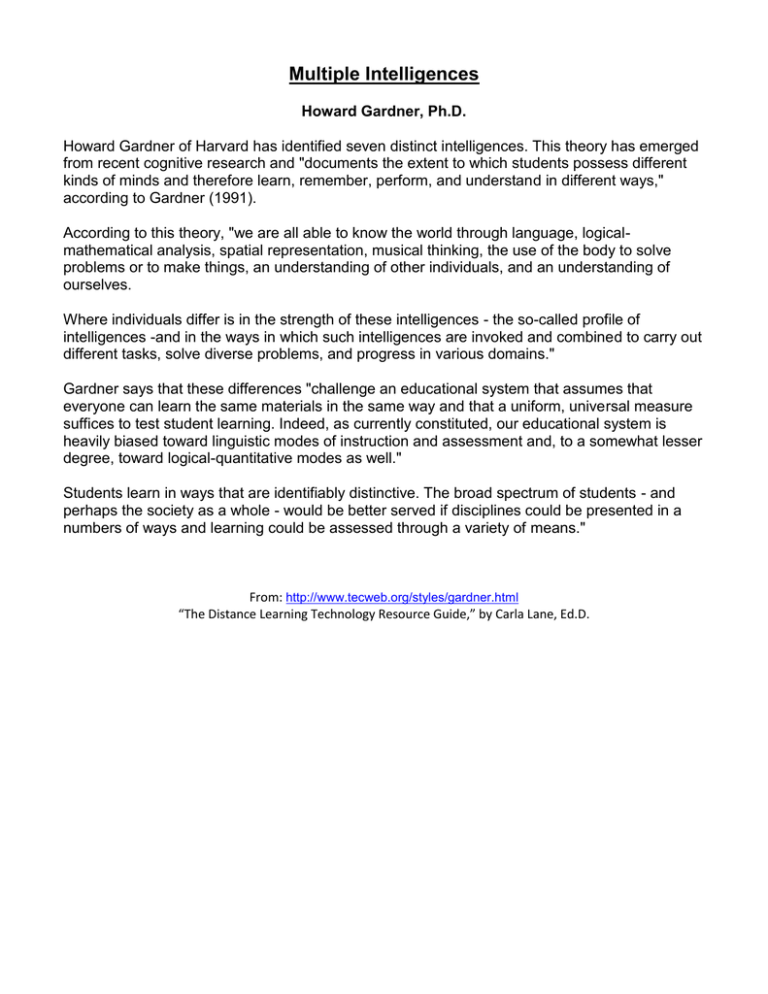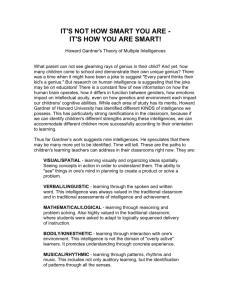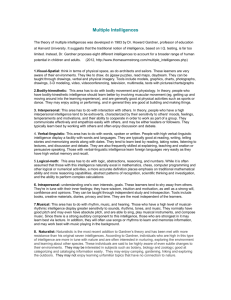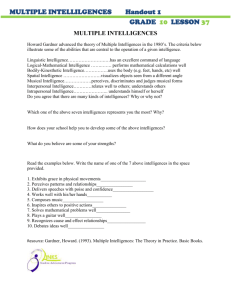
Multiple Intelligences
Howard Gardner, Ph.D.
Howard Gardner of Harvard has identified seven distinct intelligences. This theory has emerged
from recent cognitive research and "documents the extent to which students possess different
kinds of minds and therefore learn, remember, perform, and understand in different ways,"
according to Gardner (1991).
According to this theory, "we are all able to know the world through language, logicalmathematical analysis, spatial representation, musical thinking, the use of the body to solve
problems or to make things, an understanding of other individuals, and an understanding of
ourselves.
Where individuals differ is in the strength of these intelligences - the so-called profile of
intelligences -and in the ways in which such intelligences are invoked and combined to carry out
different tasks, solve diverse problems, and progress in various domains."
Gardner says that these differences "challenge an educational system that assumes that
everyone can learn the same materials in the same way and that a uniform, universal measure
suffices to test student learning. Indeed, as currently constituted, our educational system is
heavily biased toward linguistic modes of instruction and assessment and, to a somewhat lesser
degree, toward logical-quantitative modes as well."
Students learn in ways that are identifiably distinctive. The broad spectrum of students - and
perhaps the society as a whole - would be better served if disciplines could be presented in a
numbers of ways and learning could be assessed through a variety of means."
From: http://www.tecweb.org/styles/gardner.html
“The Distance Learning Technology Resource Guide,” by Carla Lane, Ed.D.
Multiple Intelligences—Howard Gardner, Ph.D.
The multiple intelligence learning styles are as follows:
Visual-Spatial - think in terms of physical space, as do architects and sailors. Very aware of their
environments. They like to draw, do jigsaw puzzles, read maps, daydream. They can be taught through
drawings, verbal and physical imagery. Tools include models, graphics, charts, photographs, drawings,
3-D modeling, video, videoconferencing, television, multimedia, texts with pictures/charts/graphs.
Bodily-kinesthetic - use the body effectively, like a dancer or a surgeon. Keen sense of body
awareness. They like movement, making things, touching. They communicate well through body
language and be taught through physical activity, hands-on learning, acting out, role playing. Tools
include equipment and real objects.
Musical - show sensitivity to rhythm and sound. They love music, but they are also sensitive to sounds in
their environments. They may study better with music in the background. They can be taught by turning
lessons into lyrics, speaking rhythmically, tapping out time. Tools include musical instruments, music,
radio, stereo, CD-ROM, multimedia.
Interpersonal - understanding, interacting with others. These students learn through interaction. They
have many friends, empathy for others, street smarts. They can be taught through group activities,
seminars, dialogues. Tools include the telephone, audio conferencing, time and attention from the
instructor, video conferencing, writing, computer conferencing, E-mail.
Intrapersonal - understanding one's own interests, goals. These learners tend to shy away from others.
They're in tune with their inner feelings; they have wisdom, intuition and motivation, as well as a strong
will, confidence and opinions. They can be taught through independent study and introspection. Tools
include books, creative materials, diaries, privacy and time. They are the most independent of the
learners.
Linguistic - using words effectively. These learners have highly developed auditory skills and often think
in words. They like reading, playing word games, making up poetry or stories. They can be taught by
encouraging them to say and see words, read books together. Tools include computers, games,
multimedia, books, tape recorders, and lecture.
Logical -Mathematical - reasoning,calculating. Think conceptually, abstractly and are able to see and
explore patterns and relationships. They like to experiment, solve puzzles, ask cosmic questions. They
can be taught through logic games, investigations, mysteries. They need to learn and form concepts
before they can deal with details.
From: http://www.tecweb.org/styles/gardner.html
“The Distance Learning Technology Resource Guide,” by Carla Lane, Ed.D.
Learning Activities Connected to Gardner’s Multiple Intelligences
Verbal-Linguistic Intelligence (Word Smart)
Description: Verbal-linguistic students love words and use them as a primary way of thinking and
solving problems. They are good writers, speakers, or both. They use words to persuade, argue,
entertain, and/or teach.
Learning Activities and Project Ideas:
Completing crossword puzzles with vocabulary words.
Playing games like Scrabble, Scrabble Junior, or Boggle.
Writing short stories for a classroom newsletter.
Writing feature articles for the school newspaper.
Writing a letter to the editor in response to articles.
Writing to state representatives about local issues.
Using digital resources such as electronic libraries, desktop publishing, word games, and word
processing.
Creating poems for a class poetry book.
Entering their original poems in a poetry contest.
Listening to a storyteller.
Studying the habits of good speakers.
Telling a story to the class.
Participating in debates.
Logical-Mathematical Intelligence (Math Smart)
Description: Logical-mathematical students enjoy working with numbers. They can easily interpret data
and analyze abstract patterns. They have a well-developed ability to reason and are good at chess and
computer programming. They think in terms of cause and effect.
Learning Activities and Project Ideas:
Playing math games like mancala, dominoes, chess, checkers, and Monopoly.
Searching for patterns in the classroom, school, outdoors, and home.
Conducting experiments to demonstrate science concepts.
Using math and science software such as Math Blaster, which reinforces math skills, or King's Rule,
a logic game.
Using science tool kits for science programs.
Designing alphabetic and numeric codes.
Making up analogies.
Spatial Intelligence (Picture Smart)
Description: Students strong in spatial intelligence think and process information in pictures and
images. They have excellent visual receptive skills and excellent fine motor skills. Students with this
intelligence use their eyes and hands to make artistic or creatively designed projects. They can build with
Legos, read maps, and put together 1,000-piece jigsaw puzzles.
Learning Activities and Project Ideas:
Taking photographs for assignments and classroom newsletters.
Taking photographs for the school yearbook, school newsletter, or science assignments.
Using clay or play dough to make objects or represent concepts from content-area lessons.
Using pictorial models such as flow charts, visual maps, Venn diagrams, and timelines to connect
new material to known information.
Taking notes using concept mapping, mind mapping, and clustering.
Using puppets to act out and reinforce concepts learned in class.
Using maps to study geographical locations discussed in class.
Illustrating poems for the class poetry book by drawing or using computer software.
Using virtual-reality system software.
Musical Intelligence (Music Smart)
Description: Musical students think, feel, and process information primarily through sound. They have a
superior ability to perceive, compose, and/or perform music. Musically smart people constantly hear
musical notes in their head.
Learning Activities and Project Ideas:
Writing their own songs and music about content-area topics.
Putting original poems to music, and then performing them for the class.
Setting a poem to music, and then performing it for the class.
Incorporating a poem they have written with a melody they already know.
Listening to music from different historical periods.
Tape recording a poem over "appropriate" background music (i.e., soft music if describing a kitten,
loud music if they are mad about pollution).
Using rhythm and clapping to memorize math facts and other content-area information.
Listening to CDs that teach concepts like the alphabet, parts of speech, and states and capitals
(i.e.,Schoolhouse Rock!).
Bodily-Kinesthetic (Body Smart)
Description: Bodily-kinesthetic students are highly aware of the world through touch and movement.
There is a special harmony between their bodies and their minds. They can control their bodies with
grace, expertise, and athleticism.
Learning Activities and Project Ideas:
Creating costumes for role-playing, skits, or simulations.
Performing skits or acting out scenes from books or key historical events.
Designing props for plays and skits.
Playing games like Twister and Simon Says.
Using charades to act out characters in a book, vocabulary words, animals, or other content-area
topics.
Participating in scavenger hunts, searching for items related to a theme or unit.
Acting out concepts. For example, for the solar system, "student planets" circle around a "student
sun." Students line up appropriately to demonstrate events in a history timeline.
Participating in movement breaks during the day.
Building objects using blocks, cubes, or Legos to represent concepts from content-area lessons.
Using electronic motion-simulation games and hands-on construction kits that interface with
computers.
Interpersonal (People Smart)
Description: Students strong in interpersonal intelligence have a natural ability to interact with, relate to,
and get along with others effectively. They are good leaders. They use their insights about others to
negotiate, persuade, and obtain information. They like to interact with others and usually have lots of
friends.
Learning Activities and Project Ideas:
Working in cooperative groups to design and complete projects.
Working in pairs to learn math facts.
Interviewing people with knowledge about content-area topics (such as a veteran to learn about
World War II, a lab technician to learn about life science, or a politician to understand the election
process).
Tutoring younger students or classmates.
Using puppets to put on a puppet show.
Intrapersonal Intelligence (Self Smart)
Description: People with a strong intrapersonal intelligence have a deep awareness of their feelings,
ideas, and goals. Students with this intelligence usually need time alone to process and create.
Learning Activities and Project Ideas:
Writing reflective papers on content-area topics.
Writing essays from the perspective of historical figures, such as Civil War soldiers or suffragettes.
Writing a literary autobiography, reflecting on their reading life.
Writing goals for the future and planning ways to achieve them.
Using software that allows them to work alone, such as Decisions, Decisions, a personal choice
software, or the Perfect Career, a career choice software.
Keeping journals or logs throughout the year.
Making a scrapbook for their poems, papers, and reflections.
Naturalistic Intelligence (Nature Smart)
Description: This intelligence refers to a person's natural interest in the environment. These people
enjoy being in nature and want to protect it from pollution. Students with strong naturalistic intelligence
easily recognize and categorize plants, animals, and rocks.
Learning Activities and Project Ideas:
Caring for classroom plants.
Caring for classroom pets.
Sorting and classifying natural objects, such as leaves and rocks.
Researching animal habitats.
Observing natural surroundings.
Organizing or participating in park/playground clean-ups, recycling drives, and beautification projects.
http://www.scholastic.com/teachers/article/clip-save-checklist-learning-activities-connect-multipleintelligences
Curiosity is the Mother of Intelligence
Why is curiosity so important?
1. It makes your mind active instead of passive.
Curious people always ask questions and search for answers in their minds. Their minds are
always active. Since the mind is like a muscle which becomes stronger through continual
exercise, the mental exercise caused by curiosity makes your mind stronger and stronger.
2. It makes your mind observant of new ideas.
When you are curious about something, your mind expects and anticipates new ideas related to
it. Without curiosity, the ideas may pass right in front of you and yet you miss them because
your mind is not prepared to recognize them.
3. It opens up new worlds and possibilities.
By being curious you will be able to see new worlds and possibilities which are normally not
visible. They are hidden behind the surface of normal life, and it takes a curious mind to look
beneath the surface and discover these new worlds and possibilities.
4. It brings excitement into your life.
The life of curious people is far from boring. It’s neither dull nor routine. There are always new
things that attract their attention. There are always new ‘toys’ to play with. Instead of being
bored, curious people have an adventurous life.
From: http://woip.blogspot.com/2007/11/curiosity-is-mother-of-intelligence.html
Curiosity is the Mother of Intelligence
Tips to Develop Curiosity
1. Keep an open mind
This is essential if you are to have a curious mind. Be open to learn, unlearn, and relearn. Some
things you know and believe might be wrong, and you should be prepared to accept this possibility
and change your mind.
2.
Don’t take things as granted
If you just accept the world as it is without trying to dig deeper, you will certainly lose the ‘holy
curiosity’. Never take things as granted. Try to dig deeper beneath the surface of what is around you.
3.
Ask questions relentlessly
A sure way to dig deeper beneath the surface is asking questions: What is that? Why is it made that
way? When was it made? Who invented it? Where does it come from? How does it work? What, why,
when, who, where, and how are the best friends of curious people.
4.
Don’t label something as boring
Whenever you label something as boring, you close one more door of possibilities. Curious people
are unlikely to call something as boring. Instead, they always see it as a door to an exciting new
world. Even if they don’t yet have time to explore it, they will leave the door open to be visited another
time.
5. See learning as something fun
If you see learning as a burden, there’s no way you will want to dig deeper into anything. That will just
make the burden heavier. But if you think of learning as something fun, you will naturally want to dig
deeper. So look at life through the glasses of fun and excitement and enjoy the learning process.
6. Read diverse kinds of reading
Don’t spend too much time on just one world; take a look at another worlds. It will introduce you to
the possibilities and excitement of the other worlds which may spark your interest to explore them
further. One easy way to do this is through reading diverse kinds of reading. Try to pick a book or
magazine on a new subject and let it feed your mind with the excitement of a new world.
From: http://woip.blogspot.com/2007/11/curiosity-is-mother-of-intelligence.html
Experiencing the World without Vision
Imagine a child who is blind visiting the beach for the first time. He hears the lapping of waves on the shore, but
may not identify it as water unless he is within touching distance. He feels the dry and wet sand, but has no way
of perceiving the whole beach as it stretches along the shore. The sounds of others playing in the sun come to
him, but he may not understand that Frisbees are flying or a volleyball is being hit, since he has never seen them.
Perhaps his interest in listening to and imitating the family on the next blanket speaking in a language he does not
understand goes unnoticed or is discouraged. He may be startled when someone slathers him with sunscreen,
especially if it is cold and is applied suddenly, without warning or explanation. Someone may remove his shoes
and set them aside without him being aware of where they are. The shoes will be lost to him until someone
produces them at the end of the day. The boy may not initiate digging in the sand, not having seen others
engaging in castle building. He may dislike the sensation of sand on his skin, particularly inside his sandals and
swim trunks. If he is settled on a beach blanket and handed a sandwich and a cold juice box, it may feel like a
magical event; cold food and drink appearing out of the warm air. The cawing of seagulls, the barking of a dog,
and the buzzing of insects have no visual cues connected with them, making them mysterious, perhaps
meaningless, or maybe anxiety-provoking. He may feel the vastness of the ocean, the expanse of the blue sky,
and the openness of the beach through the wind, the sounds drifting in and out of hearing distance, and the
warmth of the sun. Without visual images, however, his sense of what it is to be on a beach is very different from
that of his sighted peers.
Imagine instead that a girl who is blind goes to the beach for the first time with someone who takes pleasure in
introducing her to the joys of summer. She will have an entirely different experience. Her companion, who may
be sighted or blind, has described where they are going so that she has some preparation for what awaits her as
she first sets foot on the beach. She anticipates eating a picnic lunch on the beach, and she has helped to buy the
food and pack it in the ice chest. The two beachgoers have loaded it into the car and carried it from the car to the
beach. Together, they have paused to pick up some sand and feel it sift through their fingers before they venture
to the shore. Her friend has pointed out how the sand becomes damper the closer they get to the water. She
may have picked up some more sand on her own to examine the change in texture. She has helped spread the
blanket on the sand, noticing how the wind makes it difficult to spread it flat. When she has listened to an
explanation of why it is important to protect her skin from the sun, she is prepared to rub the parts she can reach
with sunscreen and to ask for help with the parts she cannot reach. Her attention to the sounds, smells and
tactile sensations at the beach is appreciated and forms an important part of the friends’ conversation. With
assistance, she has stashed her shoes in a bag on a particular corner of the blanket; her friend hopes she will
remember where to retrieve them when it is time to put them on and go home.
The day has been rich in information and less scary than it might have been. Her friend has answered questions
and shown her, in small, understandable, and pleasant steps, what is enjoyable and interesting at the beach. She
may not comprehend how huge the ocean looks or how beautiful the sky is that day, but she has had a better
chance of relaxing in the sun, enjoying a swim, and feeling like one of the magicians who produced the lovely
picnic at the beach.
Reprinted from Frances K. Liefert, "Experiencing the World Without Vision," from "Introduction to Visual Impairment" in S. A.
Goodman and S. H. Wittenstein, Editors, Collaborative Assessment: Working with Students Who Are Blind or Visually Impaired,
Including Those with Additional Disabilities. pp. 1-3. Copyright ©2003. New York: AFB Press, American Foundation for the
Blind. All rights reserved.
Suggestions for contents of treasure chest/sensory box
Excerpt from The Comprehending Hand by Lilli Nielsen
1.
2.
3.
4.
5.
6.
7.
8.
9.
10.
11.
12.
13.
14.
15.
16.
17.
18.
19.
20.
21.
22.
23.
24.
25.
26.
27.
28.
29.
30.
31.
32.
33.
34.
35.
36.
37.
38.
39.
Plastic plates (dinner, soup)
Plastic cups and saucers
Brushes of all sizes and shapes
Washing-up brushes (wood, plastic)
Pan cleaners
Nail brushes, clothes brushes, hairbrushes, shoe
brushes
Pyramids of all sizes and shapes (Models in the
shape of animals ought not be called by animal
names, as the names have no meaning for blind
children)
Milk mugs (plastic and stainless steel)
Tooth mugs (plastic and stainless steel)
Tins with screw tops (different sizes)
Tins with press-on lids (different sizes)
Metal tins with vanilla (empty and full)
Small packets of raisins
Clothes pegs (wooden and plastic)
Building beakers (round, rectangular)
Building bricks box with sliding lid
Combs
Toothbrushes
Spectacle case with spectacles (sun glasses of
plastic)
Soap box with soap
Purses with different kinds of fasteners
Plastic and metal tins with a round hold in the lid
Cardboard and wooden boxes with round hole in
the top
Scissors. Magnet. Torches
Cloth bags 8x4 inches, containing dried peas rice
small pebbles
A set of playing cards (well used)
1 ½ - yards legth of rope (leather thong type)
For binding-games and exercising dressing
movements
Plastic tin containing buttons (with slit in top like
a money box)
Doorlock with key
Bags made of cloth, strong canvas, leather
Paper coffee bags
Balls of all sizes and material
Blocks which can be joined together with sticks
Musical boxes
Large bolts with wing nuts
Parsley cutter
Pepper mill
Oranges – small, large; carrots
Large cardboard boxes
40.
41.
42.
43.
44.
45.
46.
47.
48.
49.
50.
51.
52.
53.
54.
55.
56.
57.
58.
59.
60.
61.
62.
63.
64.
65.
66.
67.
68.
69.
70.
71.
72.
73.
74.
75.
76.
77.
78.
79.
80.
Vacuum cleaner hose
Comb in case
Rattles (football fan type)
Different kinds of paper
Bundles of round sticks
Balloons (inflated with mountpiece)
Electric light switches
Handbags with different kinds of fasteners
Tiddleywinks
A round stick with white tape/ribbon (for
winding and unwinding)
Office aids – stapling machine, hole puncher
Mouth-organ (harmonica)
Spoons, teaspoons, 3 teaspoons bound together
with rubber band
Boxes (all sizes, with lids)
Pencil cases – of leather, wood (sliding lid)
Measuring spoons, kitchen spoons (wood,
plastic)
Buttons, small mosiaic pieces, pearls (large, small,
round, oblong)
Steel springs, screws, hooks
Flamingo foam, plastic material
Bells
Rubber bands (small, large, thin, thick)
Small and large balls of glass, wood, rubber,
cotton wool – table tennis balls
Wooden blocks of all sizes
Blocks of wood in book size
Balls of wool
Odd pieces of leather and skin
Picture book made of hardboard with holes: the
“pictures” can be for example, cloth with a
sipper, cloth with one button and buttonhole
Belt with buckle, string with beads to be drawn
up and down
String with beads to be drawn to and fro
Clothes pegs, rubber bands
Curtain rings (one large and one small)
Ear syringe
Castanets
Pencil case (leather with zipper)
Egg beater.
Cardboard tube with approx. 30 elastic bands
Flat box (cigar box) with elastic bands
2 triangles
Flat, round wooden blocks (different sizes)
Cycle bell mounted on a piece of a broomstick
Pieces of veneer (40x 10 cm)
81. Round toothbrush dispenser (containing a
marble)
82. Small round tins and containers (different
materials), containing a marbel
83. Long cardboard tubular containers, clothcovered
and containing rice, peas, etc.
84. Buttons and pearl shells on 2 pieces of string tied
in the middle giving 4 “spiderlegs”
85. Cotton reels threaded on a string
86. Tea egg with marble inside
87. Plastic box – thin – with clothes pegs mounted
on edge.
88. Piece of cardboard with clothes pegs mounted
89. A piece of “Velcro” – approx. 15 cm
90. Clothes pegs joined together to make small
“sticks”
This document contains a variety of forms and information about
objects to use with students when using the Active Learning
approach developed by Dr. Lilli Nielsen. These are not approved by
Dr. Nielsen and only offered as tools that teachers might fine helpful
in documenting their observations of a student while attempting to
use the Active Learning approach defined by Dr. Nielsen.
From TSBVI Outreach Programs
91.
92.
93.
94.
95.
A ball net containing balls
A door hinge
A sliding door lock
Cloth bag with zipper (containing paper)
Cloth bag with snap fastener (paper or other
materials inside)
96. Bicycle pump, bicycle inner tube
97. Rolling-pin
98. Kitchen timer
99. Rubber horn
100. Blocks of wood the size of bricks
101. Hula-hula rings
102. Broom handles
103. Alarm clock Sprinkler (for laundry use)
104. Scent spray
105. Kitchen beater (same system as spiral
screwdriver)
106. Dustpan and hand brush
107. Plastic tubing (for blowing into water)
108. Drinking straws
109. Whistle
110. Dried peas, etc. for “stirring” and “pouring”
games
111. Bonnets, caps, hats
112. Gloves
Wellingtons – golashes, other kinds of foot wear in a large
size
Websites for Activities to Stimulate the Senses:
(Check out lots of creative ideas on Pinterest and YouTube)
http://www.notimeforflashcards.com/other-activities/sensory-activities
http://therapystreetforkids.com/Sensory2.html
http://www.tsbvi.edu/instructional-resources/1913-creating-educational-toys-and-activities-forchildren-who-are-blind-or-visually-impaired
http://www.recreationtherapy.com/tx/txsensor.htm
http://wendyjanelle.blogspot.com/2010/05/sensory-steps.html





